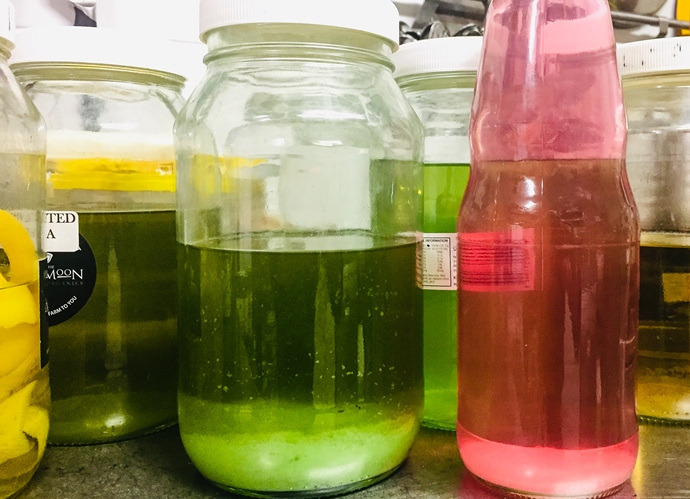Aromatic - organic - exotic
Our first ever batch of Italian-style red Vermouth is ready for your enjoyment.
From the organic potager garden and vineyard, comes…
… carefully created tinctures…
capturing the aromatics of a wide range of botanicals, including herbs, fruit and endemic Australian species
Vermouth… what is it?
Vermouth is a fortified, aromatic wine based on grapes, herbal tinctures, spices, flowers, nuts and other edible compounds, including those with bitter characteristics. It can be made sweet or dry, and show hues from red through to almost clear
Vermouth is enjoyed as an aperitif or a digestif, and also in various cocktails. It also adds deliciousness to cooking. The main characteristic of Vermouth is bitter-sweet, but the sweetness level varies from almost dry to unctuous.
Why drink Vermouth?
I have my reasons, you will no doubt have yours….but for an interesting 2020 perspective on it, please read this fab article
History of vermouth
Like so many alcoholic beverages we consume, Vermouth has a long history as a medicinal product. Although the basis of Vermouth - aromatised wine - has been around since the middle ages, the actual naming and production of Vermouth as we know it today - a fortified wine based on aromatics from wormwood - began in Italy in the late 1700s.
The name Vermouth is from the French pronunciation of the German word for wormwood - Vermut. Wormwood’s botanical name is Artemisia Absinthe and one would not be forgiven for not recognizing the infamous “green fairy” connection. Absinthe - the very strong liquor that was once outlawed for its apparent hallucinogenic effects - is also made from wormwood. However the difference between the two beverages is stark in both taste and in alcohol content. Vermouth is typically between 14 and 18% v/v alcohol (somewhere between a strong wine and a port). Absinthe is now around 45% like other spirit…although in its heyday, when it earned the (false) accusation of being a dangerously addictive psychoactive drug - it was often sold at much higher levels of alcohol, and of dubious quality of distillation. Thuojene is the compound found in Wormwood that in very high concentrations can be toxic. In the barely detectable amounts found in modern Absinthe and in Vermouth, it is quite harmless. So, no green fairies for you my friend!
The vermOuth makiNg process
As depicted in the info-graphic, Vermouth is a grape-based wine product flavoured with aromatic compounds derived from the fruit, leaves and roots of edible plants, and fortified with alcohol. There are several ways of making Vermouth, but Elixyr Botanica is made using estate grown organic Merlot grape juice, to which is added organic Rose wine & vin cotto (both also made from Merlot), locally produced grape spirit and tinctures of estate grown (certified organic) herbs, spices, nuts, honey and flowers. A careful balance of sweetness and bitterness is achieved to complement the myriad flavours from the aromatic tinctures in this Rosso (sweet, red, Italian) style. Most other Vermouths are typically made with white wine and added sugar instead of grape juice, then they are coloured with caramel which imparts a distinctive flavour characteristic.
The Elixyr Botanica difference
Elixyr Botanica has a fresh, bright and fragrant character because it doesn’t have the caramel interfering. The use of grape juice instead of sugar has obvious health benefits, but also allows some of the Merlot aromas to contribute to the Vermouth. We’ve also sought to be low-interventionist, and thus we haven’t filtered nor fined the Vermouth so expect it to be rich with colour, flavour and texture. You will also enjoy it knowing that it is a locally produced and organic. Good for you. Good for the Planet.
Enjoying Vermouth
Walk into any bar in Barcelona or Madrid around noon, and you will be surrounded by those enjoying the hora de vermut - vermouth hour. The locals (and savvy visitors) will be enjoying a little glass of Vermouth served neat, probably on ice as an appetite booster before lunch. Most people in Spain drink their vermouth with a couple extras, such as an olive, an orange wedge or a splash of sparkling water.
The Italians likewise tend to enjoy their Vermouths (red, sweet) as an undiluted drink whereas traditionally, in the USA & UK, Vermouth has been consumed as a cocktail ingredient. Prime examples of Vermouth dominant cocktails include the Manhattan and the Martini with sweet red and dry white vermouths respectively. The Negroni also relies on Vermouth as a fundamental base.
Cooking with Vermouth is no recent phenomenon, although as we’ve not been drinking much of it between the 1970s and 2000s it hasn’t appeared much in new recipes until now. Vermouth adds complexity to sauces and is exquisite when mixed with sliced apples and butter, baked until soft. Simple. Tasty. Wholesome.
You can enjoy it any way you prefer, but we recommend sharing it with friends and a tapas or two! Salud.
Further reading
If you’d like to read more about this fascinating, delicious beverage there are two recent books (in English) that are fonts of knowledge. We highly recommend them.
The Book of Vermouth. 2018. Shaun Byrne & Gilles Lapalus. Hardie Grant Publishers (Australia).
Vermouth: A Spirited Guide. 2019. Jack A. Bevan. Headline Publishing (UK).





